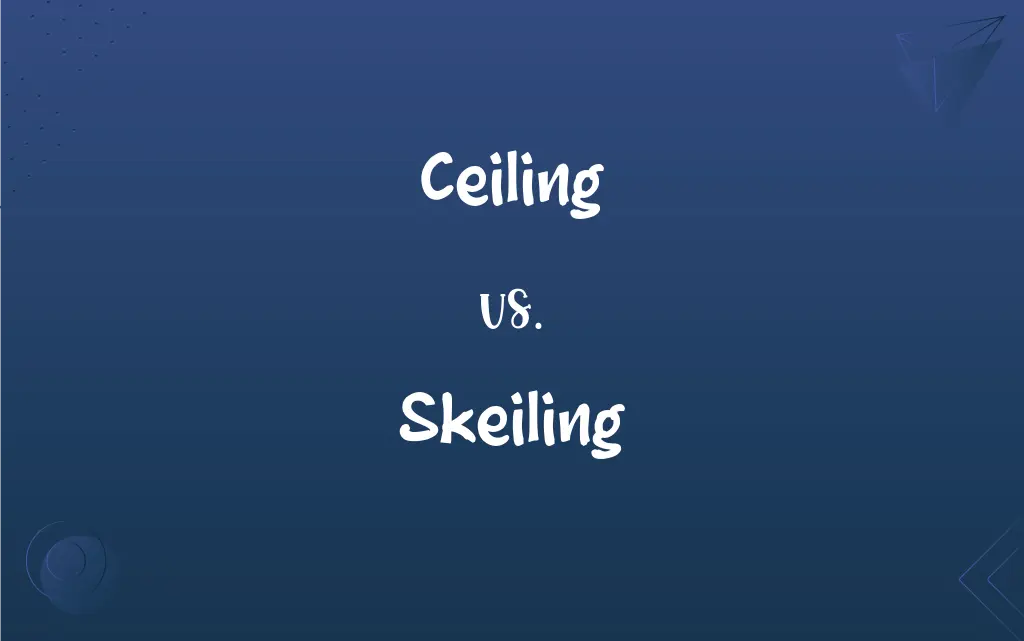Ceiling vs. Skeiling: What's the Difference?
Edited by Harlon Moss || By Janet White || Updated on October 4, 2023
A "Ceiling" is the upper interior surface of a room, while "Skeiling" refers to the sloping side of a ceiling, typically found in attics or under roofs.

Key Differences
A Ceiling is a term most are familiar with, referring to the overhead interior surface that covers the upper limits of a room. It serves both a practical and aesthetic function, often hiding plumbing, electrical wiring, and structural elements. In contrast, Skeiling is a less common term, denoting the slanted or sloped side of a ceiling, especially in spaces under a pitched roof, like attics or top-floor rooms.
While Ceilings are found in virtually every indoor space, be it residential or commercial, providing a separation between floors of a building, Skeilings are specific to rooms or spaces beneath slanted roofs. Their presence often gives a room a distinctive, cozy character, reminiscent of attic spaces.
Ceilings can be decorated or treated in a variety of ways: painted, plastered, tiled, or even adorned with moldings or frescoes. Skeilings, due to their sloped nature, are typically less embellished but can add architectural interest to a space.
One can often install fixtures, like fans or lights, on a Ceiling, leveraging its flat, horizontal nature. Skeilings, however, due to their slanted position, don't typically support such installations and are often left plain or simply painted.
In construction, when planning the interior layout of a space, the height and type of the Ceiling are critical considerations. Meanwhile, rooms with Skeilings require special attention to ensure optimal use of space, given the limitations imposed by the slope.
ADVERTISEMENT
Comparison Chart
Definition
Upper interior surface of a room.
Slanted side of a ceiling under a pitched roof.
Presence
In every indoor space.
Rooms or spaces beneath sloped roofs.
Decoration
Can be painted, plastered, tiled, etc.
Typically less embellished due to its sloped nature.
Functional Installations
Supports fixtures like fans, lights.
Rarely supports heavy fixtures due to its slanted position.
Architectural Relevance
Defines room height and style.
Adds character to spaces, requires special layout considerations.
ADVERTISEMENT
Ceiling and Skeiling Definitions
Ceiling
The overhead interior surface of a room.
The Ceiling in the living room was adorned with intricate moldings.
Skeiling
The part of a ceiling that angles or slopes.
The Skeiling made the room feel more spacious than it was.
Ceiling
A barrier that sets an upper limit.
Glass ceilings can often hinder progress in some fields.
Skeiling
The sloping side of a ceiling under a roof.
The Skeiling added a cozy touch to the attic bedroom.
Ceiling
An upper limit set on prices, wages, or expenditure.
The government has imposed a Ceiling on housing prices.
Skeiling
The inclined surface on the sides of a room under a pitched roof.
She painted the Skeiling a soft blue to match the room's decor.
Ceiling
The maximum altitude an aircraft can reach.
The plane has a Ceiling of 35,000 feet.
Skeiling
An angled ceiling surface beneath a roof's eaves.
The Skeiling was lined with bookshelves, making use of the unique space.
Ceiling
The upper interior surface of a room.
Skeiling
The sloped part of an interior, often found in attics.
He set up his study beneath the Skeiling, giving it a quaint feel.
Ceiling
Material used to cover this surface.
Skeiling
(architecture) A straight sloped part of a ceiling, such as on the underside of a pitched roof.
Ceiling
Something resembling a ceiling
A ceiling of leaves over the arbor.
Ceiling
An upper limit, especially as set by regulation
Wage and price ceilings.
Ceiling
The highest altitude under particular weather conditions from which the ground is still visible.
Ceiling
The altitude of the lowest layer of clouds.
Ceiling
The maximum altitude that an aircraft can reach under a given set of conditions, such as a minimum rate of climb.
Ceiling
(Nautical) The planking applied to the interior framework of a ship.
Ceiling
The overhead closure of a room.
The dining room had an ornate ceiling.
Ceiling
The upper limit of an object or action.
Ceiling
(aviation) The highest altitude at which an aircraft can safely maintain flight.
Ceiling
(meteorology) The measurement of visible distance from ground or sea level to an overcast cloud cover; under a clear sky, the ceiling measurement is identified as "unlimited."
Even though it was cloudy, there was still enough ceiling for the Blue Angels to perform a great show.
Ceiling
(mathematics) The smallest integer greater than or equal to a given number.
The ceiling of 4.5 is 5; the ceiling of −4.5 is −4.
Ceiling
(nautical) The inner planking of a vessel.
Ceiling
(finance) The maximum permitted level in a financial transaction.
Ceiling
(architecture) The overhead interior surface that covers the upper limits of a room.
Ceiling
The inside lining of a room overhead; the under side of the floor above; the upper surface opposite to the floor.
Ceiling
The inner planking of a vessel.
Ceiling
The overhead upper surface of a room;
He hated painting the ceiling
Ceiling
(meteorology) altitude of the lowest layer of clouds
Ceiling
An upper limit on what is allowed;
They established a cap for prices
Ceiling
Maximum altitude at which a plane can fly (under specified conditions)
Ceiling
The upper boundary of a space indoors.
She gazed up at the Ceiling, lost in thought.
FAQs
Can you hang a chandelier from a Skeiling?
It's uncommon to hang heavy fixtures from a Skeiling due to its slanted nature, but it depends on construction.
Can a Ceiling be decorative?
Absolutely, Ceilings can be adorned with paint, moldings, frescoes, and more.
Are Skeilings common in modern homes?
Skeilings are specific to spaces under pitched roofs, so their presence depends on the home's design.
Does a Ceiling always refer to architecture?
While commonly architectural, Ceiling can also refer to upper limits in other contexts, like finance.
Are Skeilings always sloped?
Yes, by definition, a Skeiling is the sloped or slanted side of a ceiling.
Where can you find a Ceiling?
A Ceiling is the upper interior surface found in virtually every indoor space.
What is the main purpose of a Skeiling?
A Skeiling refers to the sloping side of a ceiling under a pitched roof, often adding character to a space.
Do all homes have Ceilings?
Yes, virtually all indoor spaces have Ceilings that cover the upper limits of a room.
Do Skeilings impact room acoustics?
The angle of a Skeiling can affect room acoustics, sometimes enhancing or diminishing sound qualities.
How do you decorate a Skeiling?
Skeilings are often painted, but due to their slope, decorations are typically minimalistic.
Can a Ceiling be a structural element?
Yes, in some designs, the Ceiling plays a structural role, supporting weight or adding rigidity.
Can you install lights on a Ceiling?
Yes, lights, fans, and other fixtures can be installed on a Ceiling.
What materials can Ceilings be made of?
Ceilings can be made of plaster, wood, metal, tiles, and more.
Can Ceilings have textures?
Absolutely, Ceilings can have various textures, from popcorn to coffered styles.
Can a room have both a Ceiling and a Skeiling?
Yes, a room can have a flat Ceiling with parts of it transitioning into a Skeiling due to a pitched roof.
Are Skeilings limited to attics?
While common in attics, any room under a sloped roof can have a Skeiling.
How do you clean a Ceiling?
Ceilings can be cleaned with a duster, brush, or specialized cleaning tools.
Is it hard to maintain a Skeiling?
Maintaining a Skeiling is similar to other ceiling surfaces but might require care due to its angle.
Can Skeilings be soundproofed?
Yes, like other surfaces, Skeilings can be soundproofed using specialized materials.
Is there a height standard for Ceilings?
While there's no universal standard, many residential Ceilings are 8-9 feet high.
About Author
Written by
Janet WhiteJanet White has been an esteemed writer and blogger for Difference Wiki. Holding a Master's degree in Science and Medical Journalism from the prestigious Boston University, she has consistently demonstrated her expertise and passion for her field. When she's not immersed in her work, Janet relishes her time exercising, delving into a good book, and cherishing moments with friends and family.
Edited by
Harlon MossHarlon is a seasoned quality moderator and accomplished content writer for Difference Wiki. An alumnus of the prestigious University of California, he earned his degree in Computer Science. Leveraging his academic background, Harlon brings a meticulous and informed perspective to his work, ensuring content accuracy and excellence.































































